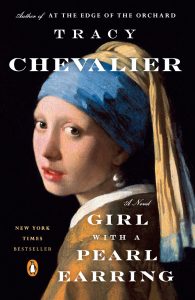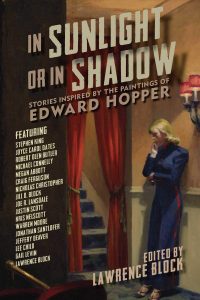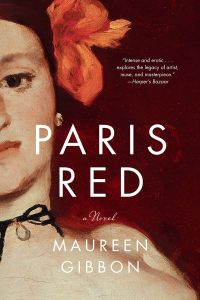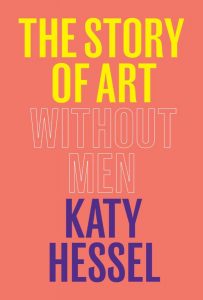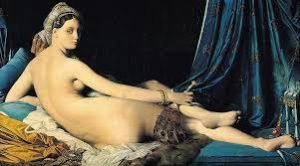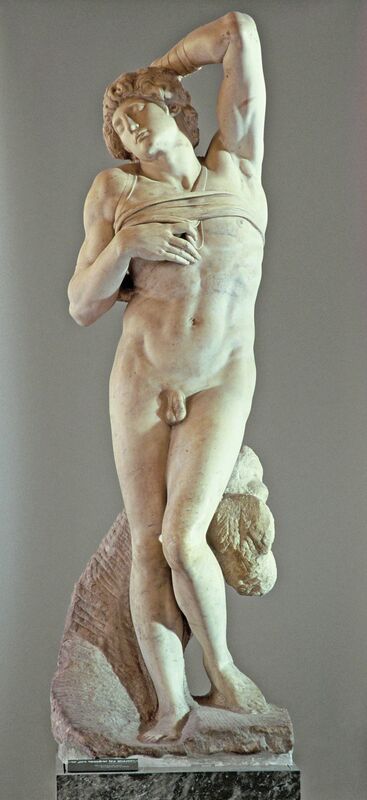Sister Gertrude Morgan
Apr 11th, 2023 by rhperry0033
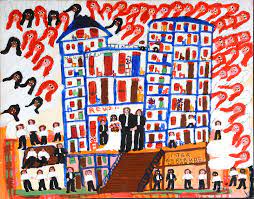
- Sister Morgan was a self-taught artist and used simple forms to depict the human figure, which was a common art style found among others who taught themselves. Because of this, as well as due to her materials of choice and subject matter, led her to be characterized as a folk-style visionary and outsider artist.
- In 1957 Sister Morgan received a revelation from God in her dreams, stating that she heard a voice that told her that she was the Bride of Christ. She then promptly discontinued wearing her black missionary attire and adopted an all-white style instead that included a nurses’ uniform and a peaked nurses’ cap.
- In 1973 she announced that the Lord had ordered her to cease painting in order to concentrate on her preaching and poetry.
Story: Sister Morgan had been enjoying the fruits of her fame and wealth as well as the company of her religion when she begins to question the voices in her head and starts to wonder if it was God all along, or perhaps Satan instead…
The Story of Art Without Men
Apr 6th, 2023 by JGB
Female Nude
Mar 22nd, 2023 by Eleanor Yeatts
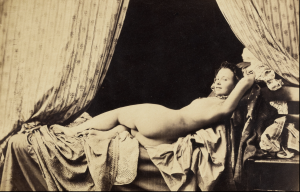 Felix-Jacque Moulin’s “Female Nude” was an influential piece of art history in the mid 1800’s. Moulin was sentenced to a month in prison after some of his nude art was seized by the police. After his incarceration he took more caution with his work by registering his work with the government so that he could claim official sanction. This photo was not signed, likely because he did not want to get in trouble for it, and due to the model’s particularly seductive stare, it is likely he would have faced legal consequences for this work. He worked in his studio in Paris, just like his character in Paris Red. I see Victorine in this work; her sly smile is indicative of the pleasure she takes in posing, in being seen. I’m curious if part of her character was based off of this photo and what Gibon saw in Moulin’s work.
Felix-Jacque Moulin’s “Female Nude” was an influential piece of art history in the mid 1800’s. Moulin was sentenced to a month in prison after some of his nude art was seized by the police. After his incarceration he took more caution with his work by registering his work with the government so that he could claim official sanction. This photo was not signed, likely because he did not want to get in trouble for it, and due to the model’s particularly seductive stare, it is likely he would have faced legal consequences for this work. He worked in his studio in Paris, just like his character in Paris Red. I see Victorine in this work; her sly smile is indicative of the pleasure she takes in posing, in being seen. I’m curious if part of her character was based off of this photo and what Gibon saw in Moulin’s work.
“Two Standing Female Nudes”
Mar 21st, 2023 by smcote
“Two Standing Female Nudes” by Félix-Jacques-Antoine Moulin is a daguerreotype from 1850. Moulin himself is one of the characters within Paris Red. In the novel, Victorine visits Moulin’s studio twice. The first time, with Nise, to be photographed as a pair and individually. Later, she revisits Moulin’s studio with Manet, to be photographed in the pose Manet was painting. Just as depicted in the novel, Moulin’s work was in photographing young women, typically in the nude. In 1851, Moulin was fined and sentenced to a month in jail for producing these images that the Cour d’assises de la Seine determined was a “violation of public morality.” Many of his images from the time disappeared, presumably destroyed by the court. Despite this, Moulin continued his photography and his sale of académies– the polite and cryptic term for nude studies used by artists. Like in the book, painters such as Manet would have purchased such académies to use as reference in art. Moulin’s photography straddles the thin line between art and erotica that was enforced by law at the time, and the attitude toward sex and “decency” which is a prominent theme of Paris Red.
Félix-Jacques Moulin
Mar 21st, 2023 by Cynthia
Félix-Jacques Moulin was a French photographer during the 1850s and 1860s, and was a character in the latest novel we read, Paris Red. His work was largely based around taking pictures of young girls, most often in the nude. In 1851, all of his works up until that point were confiscated, and Moulin was sentenced to prison for the nature of his works.  Many of them still do not have titles for this reason, as court records state that they were “so obscene that even to pronounce the titles (…) would violate public morality.” This is the case with the photograph pictured.
Many of them still do not have titles for this reason, as court records state that they were “so obscene that even to pronounce the titles (…) would violate public morality.” This is the case with the photograph pictured.
After his release, Moulin continued his work, although this time more privately. In addition, he sold photography equipment and taught lessons on the craft. In 1856, Moulin was funded by the French government to take a photographic trip to Alegeria, where he returned with almost 1900 images of landscapes, cities, archeologic surveys and portraits of inhabitants, despite his challenges with humidity, quality of water, and working out in the open. Three hundred of these images were published when he returned home.
Martyr de saint Sébastien
Mar 21st, 2023 by rhperry0033
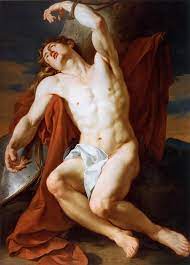 The Martyr de saint Sebastien (Also known as The Martyrdom of St Sebastian) is an oil canvas painting of the religious art genre conceived by François-Guillaume Ménageot during the second half of the eighteenth century. Standing 52.5 inches in height and 38.3 inches in weight, it currently resides within the collection of the Patrick and Beatrice Haggerty Museum of Art. François-Guillaume Ménageot, who lived from 1744 to 1816, was a French painter who specialized in works revolving around religious implications as well as French historical scenes.
The Martyr de saint Sebastien (Also known as The Martyrdom of St Sebastian) is an oil canvas painting of the religious art genre conceived by François-Guillaume Ménageot during the second half of the eighteenth century. Standing 52.5 inches in height and 38.3 inches in weight, it currently resides within the collection of the Patrick and Beatrice Haggerty Museum of Art. François-Guillaume Ménageot, who lived from 1744 to 1816, was a French painter who specialized in works revolving around religious implications as well as French historical scenes.
Ménageot worked as an artistic pupil and trained under the guidance of first Jean-Baptiste-Henri Deshays, then Joseph-Marie Vien, and lastly Francois Boucher. It was through Boucher’s influence that warm, light attributes and colorations were arrogated into Ménageot’s earlier works. In 1766, he won the Grand Prix de Rome with his work, Tomyris Plunging the Head of Cyrus into a Bowl of Blood, which also achieved the opportunity to stay at the French Academy in Rome from 1769 to 1774. He was then approved as a history painter in 1777, and his work was an immense influence on the French painters of his time. He guided the art world to re-adapt the “Grand Style” of painting, which consisted of compositions of the horizontal stature, an influx of sculptural drapery, and colder-toned colors.
The painting itself is Ménageot’s representation of Saint Sebastian, who serves as a protector against plagues, as well as a patron of soldiers, athletes, and specifically archers. He is often depicted as unclothed, tied to a tree, wearing a crown, and shot with arrows. Saint Sebastian often served as the muse for painters, although the reasoning for this varies depending on the time period. Specific saints were prioritized over others in the art world based on their morals that saintly figures who had fulfilled prayers and acknowledged miracles were ones who could be depicted in churches, sanctuaries, chapels, etc. Due to this, most saw Sebastian as one of the only opportunities (other than Jesus himself) to study and perfect their abilities of male autonomy during the Renaissance, because interest was primarily focused on the symbolic meaning rather than the style, or naked body. Furthermore, art was directed by the concept of “art for art’s sake;” the spirituality of the painting.
Jean-Auguste-Dominique Ingres’s Grande Odalisque
Mar 21st, 2023 by Emma Alexander
The Grand Odalisque (also known as Une Odalisque or La Grande Odalisque) is a painting currently located at the Louvre in Paris, France. It is 91 x 162 cm and was made in 1814 by Jean-Auguste-Dominique Ingres, a French Neoclassical painter who re-imagined Classical and Renaissance sources for more 19th century tastes. Ingres drew inspiration from Giorgione and Urbino, though this painting is directly drawn from the 1809 Portrait of Madame Récamier by Jacques-Louis David, who was his mentor. The Grand Odalisque was commissioned by Napoleon’s sister, Queen Caroline Murat of Naples.
The painting shows a nude woman in a decorative headpiece lying down upon a lavish blue bed. Though her back is turned to the viewer, she looks over her right shoulder, creating an odd curve to her back. Her right arm looks oddly long and rests across her leg, a feather fan clutched lightly in her hand. The woman is depicted as a concubine for a sultan.
What makes this painting so interesting is the fact that though it used inspiration from older paintings and shows techniques that are often reflected in Neoclassical paintings (clean lines and defined figure), Ingres distorts the woman’s body in an unnatural way. Her back looks almost too long, and so does her right arm. In comparison, her legs and face look a bit small. This distortion caused critics to see this work as a rebellion against the contemporary style of form and content; it took a very long time for this painting to be seen as a masterpiece. These stylistic choices have caused this painting to be a major starting point for discussions about the male gaze and the female subject.
“The Hallway” by Erwin Olaf
Mar 21st, 2023 by rjbillings
 “The Hallway” was photographed in 2005 by Erwin Olaf, a Dutch-born artist. Olaf was born in 1959 in Hilversum, Netherlands. After 500 of his works landed him a spot in the Rijks museum, he became a knight of the Order of the Lion for all of the work he had done. Many of his photographs included people in marginalized groups such as the LGBTQ+ community. His activism in these communities is inspiring. In fact, the Dutch royals requested portraits of themselves done by Olaf. Looking at the photograph “The Hallway,” it appears to be two people who were once close but have since grown apart. The man has his back turned to the woman while the woman has her face turned away from him. However, the woman’s body seems to inch towards him, as if hoping for a reconciliation. Her foot on the far side of us is pointed directly at him as if she is asking him to turn to look at her. The man, however, has a stern face that shows he is resolute in whatever decision he had to make.
“The Hallway” was photographed in 2005 by Erwin Olaf, a Dutch-born artist. Olaf was born in 1959 in Hilversum, Netherlands. After 500 of his works landed him a spot in the Rijks museum, he became a knight of the Order of the Lion for all of the work he had done. Many of his photographs included people in marginalized groups such as the LGBTQ+ community. His activism in these communities is inspiring. In fact, the Dutch royals requested portraits of themselves done by Olaf. Looking at the photograph “The Hallway,” it appears to be two people who were once close but have since grown apart. The man has his back turned to the woman while the woman has her face turned away from him. However, the woman’s body seems to inch towards him, as if hoping for a reconciliation. Her foot on the far side of us is pointed directly at him as if she is asking him to turn to look at her. The man, however, has a stern face that shows he is resolute in whatever decision he had to make.
St. Sebastian Votive Offering
Mar 21st, 2023 by khkyzer
The story behind St Sebastian, who is a saint from the Roman age, became a martyr due to him not renouncing his Christian faith during a rampant campaign by Roman people to persecute Christians. He had concealed his faith until he could no longer. In the painting we see that he is shot with one arrow. In many versions of this story we find the phrasing that he was left looking like a “sea urchin” due to how many arrows were shot into him to kill him for his crimes. In this painting we only see one arrow, and this particular painting was done by Angel Zarraga.
In terms of the meaning of this painting, we start with the title. A votive offering is one or more objects deposited or displayed, without the intention of recovery or use, in a sacred place. These offerings are considered to help people gain a favorable status with their chosen supernatural forces/religious god(s). In this painting St. Sebastian, takes on the same position as the Dying Slave by Michelangelo. This pose symbolizes life being drained from a person to eventually become a lifeless sack of matter. This is the acceptance of his release from his struggles of his life.
To the left of him, St. Irene sits, with her hands clasped together in a praying stance. In the story, she is known as the person who was tasked with cleaning the body of St. Sebastian, but when found alive, she nursed him back to health after being shot with arrows. To the right of him, we see a passage, which reads as follows: “Lord, I do not know how to celebrate you as a poet does in complicated verses, but Lord accept this rough and humble work I have made with my mortal hands. Angel Zarraga.” We see and read this passage as a note from the artist himself. The Mexican painter, Angel Zarraga, used this work to show his allegiance to God and his work as an offering.
In some interpretations, Angel Zarraga uses this painting as an example of his own life. His inner self being St. Sebastian and his mother being St. Irene. He explains that his mother used to teach him how to pray in the exact position. We don’t see a lot of pain on St. Sebastian’s face in this depiction and because of this reasoning, it is believed that, in this interpretation, it is from a divine encounter and being close to the divine through mediums.
Essentially, this piece covers the bliss that comes with devoting their life to God as well as being able to encounter the divine within experiences either prayer, offering, or pain.
St.Sebastian
Mar 21st, 2023 by mmwilliams5180
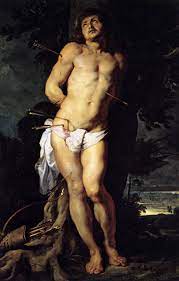 St. Sebastian (also known as the patron saint of athletes and archers) distinguished himself for his excellent service, he was promoted to serve in the Praetorian Guard to protect Emperor Diocletian. While serving in the Roman troops he made the dire mistake of convincing many of the locals to convert to Christianity. In 286 it was finally discovered that Sebastian was converting locals, and he was sentenced to be tortured to death.
St. Sebastian (also known as the patron saint of athletes and archers) distinguished himself for his excellent service, he was promoted to serve in the Praetorian Guard to protect Emperor Diocletian. While serving in the Roman troops he made the dire mistake of convincing many of the locals to convert to Christianity. In 286 it was finally discovered that Sebastian was converting locals, and he was sentenced to be tortured to death.
They punished Sebastian by tying him up to a tree and using him as an arrow target, thus we get the piece of art by Peter Paul Rubens. Archers riddled his body with arrows; his body was described as, “full of arrows as an urchin.” Believed to be dead, the archers left his body for retrieval and burial. He was recovered by Irene of Rome, whose Christian husband was a servant to Diocletian and also martyred. Irene discovered that Sebastian was still living, and she hid him and nursed him back to health. Once Sebastian was well enough he confronted the Emperor in charge of oppressing Christians. The Emperor immediately sentenced him to death by clubbing and then threw his body into a sewer.
St. Sebastian was commonly invoked as a protector against the plague. According to historical records, he was prayed to and his blessings defended the city of Rome against the plague in 680. His association with the plague could be because he survived being shot full of arrows, and in pagan belief, pestilence was delivered by arrows shot by the gods above.
The Sleeping Venus
Mar 20th, 2023 by Emily DuBois
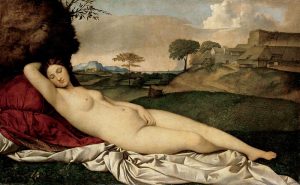
The Sleeping Venus (also known as the Dresden Venus) is currently located at Gemäldegalerie Alte Meister in Dresden, Germany. It measures 42.7 in x 69 in and was painted in 1510 by Giorgio Barbarelli da Castelfranco, otherwise known as Giorgione. The woman depicted in the painting is meant to be Venus herself and it is thought to be the first reclining nude in the history of Western painting. Initially, there was the addition of Cupid seated at Venus’s feet, but it was painted over for some unknown reason. In the 20th century, extensive x-rays were taken of the painting and researchers found that there was a large number of alterations made to the painting before reaching the appearance we see today, namely the landscape behind Venus, the drapery color, and the manner in which her head is positioned.
Giorgione (a nickname that translates to ‘Big George’) was a part of the Venetian School during the High Renaissance, where he was closely associated with Titian, his younger contemporary. The two were apprentices of Giovanni Bellini, worked on frescoes together, and both founded the Venetian School of Italian Renaissance painting.
Giorgione passed away in his 30’s from the plague and was buried on the island of Lazzareto Nuovo, leaving Titian to finish his paintings that were incomplete. The exact paintings that Titian completed are the subject of debate among art historians and critics over the past few centuries. One painting that is known to have been finished by Titian is the aforementioned Sleeping Venus, where Titian completed the landscape and sky as fit. It is widely believed that Titian’s later painting, Venus of Urbino, is inspired by the Sleeping Venus.
Le Déjeuner sur l’herbe
Mar 20th, 2023 by ashantibrown
Le Dejeuner sur l’herbe (The Luncheon on the Grass) is a large oil on canvas painting created by Édouard Manet in 1862 and 1863. The painting consists of two women who are nude and nearly nude and two men who are fully dressed in a beautiful, almost ethereal, setting. This painting is housed in the Musée d’Orsay in Paris. Just based off of the depiction of the women and men in the painting, I could tell that controversy would follow. It is said that Manet intentionally chose the size of the painting, which measures 81.9 x 104.1 inches. Such large canvases were usually reserved for historical, mythological, and religious figures. The painting was created to challenge the feminine vs the masculine, the clothed vs the naked, and the social difference between men and women during those times, which I still believe heavily applies today in the way that men and women are viewed in society. I applaud Manet’s deeper meaning in the painting and the messages that he hides behind them.
Reclining Venus (After Titian) – Lorenzo Bartolini
Mar 18th, 2023 by Grace Quintilian
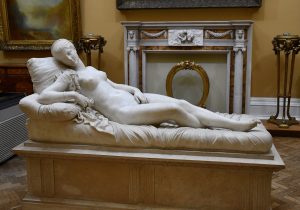 Lorenzo Bartolini was an Italian marble sculptor who lived from 1777-1850. He is known for his neoclassicist, yet naturalistic style, and after the death of Antonio Canova in 1822, he became the leading Italian sculptor. He created a variety of works, including full-body portrait statues and commissioned monuments, but he was especially well-known for his numerous portrait busts. He had a number of patrons, the most influential of whom being Napoleon, who commissioned from him a large bust of himself.
Lorenzo Bartolini was an Italian marble sculptor who lived from 1777-1850. He is known for his neoclassicist, yet naturalistic style, and after the death of Antonio Canova in 1822, he became the leading Italian sculptor. He created a variety of works, including full-body portrait statues and commissioned monuments, but he was especially well-known for his numerous portrait busts. He had a number of patrons, the most influential of whom being Napoleon, who commissioned from him a large bust of himself.
This sculpture, Reclining Venus, was inspired by Titian’s Venus of Urbino (1534). It may have been a commission by Lord Robert Castlereagh, the Marquis of Londonderry. In 1821, Bartolini received permission of the Uffizi Gallery to create this copy of Titian’s painting, and in 1822 it was finished. The sculpture is 174 cm tall (approximately 5 feet) and made out of marble. It currently resides at the Lady Lever Art Gallery in Bebington, England.
Venus of Urbino
Mar 17th, 2023 by Kate Dearie
The painting Venus of Urbino was painted in 1534 by the Italian artist, Titian. It’s an oil painting currently located at the Uffizi Gallery in Florence, Italy. What I found interesting about the painting, after I had chosen it, was how similar it was to the painting Olympia by Manet. Olympia reclines in the exact same position as Titian’s Venus—her left hand covers her genitals, and the angle at which her right arm bends is the same as Venus’s. The woman in the painting, Venus, is supposedly the Goddess of Love and Beauty. The Romans knew her as Venus, while for the Greeks she was Aphrodite.she is the ideal of feminine beauty, which is what this painting was made to represent.
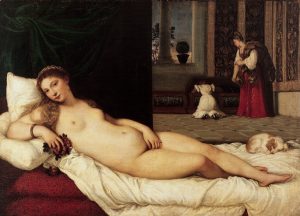 In my research, I discovered that Titian set the standard for the reclining female nude. Venus reclines on her luxurious pillowed couch, inspiring generations of painters, like Manet. Though Venus’ pose in the painting is clearly modeled after Dresden Venus by Giorgione, Titian changed the background. He moved Venus to an indoor setting, engaged her with the viewer, and made her sensuality explicit; some even believe the figure is engaging in masturbation. Of course this feature stuck out to me, as this is exactly what transpires in Paris Red as Manet paints Victorine. There was clearly heavy research involving this painting as well as Olympia for the novel Paris Red.
In my research, I discovered that Titian set the standard for the reclining female nude. Venus reclines on her luxurious pillowed couch, inspiring generations of painters, like Manet. Though Venus’ pose in the painting is clearly modeled after Dresden Venus by Giorgione, Titian changed the background. He moved Venus to an indoor setting, engaged her with the viewer, and made her sensuality explicit; some even believe the figure is engaging in masturbation. Of course this feature stuck out to me, as this is exactly what transpires in Paris Red as Manet paints Victorine. There was clearly heavy research involving this painting as well as Olympia for the novel Paris Red.
The most disturbing part of this painting’s history, and possibly part of history as a whole, is the misconception of why this painting was made, or who it was for. While Titian claims the painting was for the 21-year-old Ippolito de’ Medici before he died, there is another assumption. When Guidobaldo II della Rovere, the 24-year-old son of the Duke of Urbino came to model for a painting with Titian, he wanted to buy it. Another story is that the painting may have been commissioned by Guidobaldo, possibly to celebrate his marriage in 1534 to the 10-year-old Giulia Varano. It’s an odd gift for sure, especially to a girl of that age. But Venus’s hand “caressing” her genitals as such a reference, as it was believed at the time that a female “emission” or orgasm was necessary for conception to take place, and female masturbation was therefore allowed only in cases where the male had ejaculated and withdrawn. Quite a disturbing gift with an odd message to portray to a 10-year-old, but the production of heirs was of great concern in elite marriages.
Paris Red as an Exploration of Relationship Dynamics
Mar 16th, 2023 by smcote
One of the primary themes of Paris Red is relationships– and the changes and struggles within them, as Victorine seeks to understand herself and in part explore her sexuality. From the first line, we get a sense of her libertine way of thinking, and an insight to her relationship with herself; “Today I am seventeen and I am wearing the boots of a whore.” We come to know that she embraces her sexual desires, and learn of the ways this has impacted her life, for better or worse. From the broken relationship between herself and her parents, we see that she had always been self-assured and did not take mind of warnings or rules. She is confident as she makes her way through the world, and that seems to be one reason that allowed her to become important to Manet. She is aware of the gap between her and Manet, yet remains financially and emotionally reliant on him. In gaining him, she left her friend Denise and her job, leaving her in a precarious situation that spans the length of the novel.
There were certainly mixed emotions as I read Paris Red, many of which changed and shifted over the course of the novel. Most of this is around the constantly shifting relationships from the narrator, Victorine, as she moves between walks of life. This, of course, begins with her relationship with her then roommate, Denise, and how they have bonded over the course of their time together. This shifts and becomes complicated with Manet, who takes the two of them on shared dates where Victorine slowly takes more charge. Eventually it leads to Victorine leaving Denise and assisting Manet with his work.
The big thing that stands out to me is the varying relationship between Victorine and Manet. The artist, himself, oftentimes seems very closed off and it leaves our narrator to read his subtle changes in his facial expressions. They bond over his work, their sex life, and, eventually, the shared eye of an artist, something of which is slowly revealed to the reader and Victorine herself. Despite their closeness, they never fully define their relationship besides a model working for an artist (with some sexy parts in between).
Though I found the ending somewhat disappointing since I felt the stakes were raised mere pages before it, it nevertheless concluded in a way that allowed the reader to imagine what might have happened afterwards. I wouldn’t call it bittersweet, but it certainly was left in a comfortable place with viewing Manet’s most recent painting of her and conveying Manet’s support in Victorine’s own art. Even though the novel ends, readers can assume that they continued their half-in, half-out relationship, Victorine got part of the contact that Manet promised her, and they both continued on to pursue their art and each other.
Paris Red
Mar 16th, 2023 by Emma Alexander
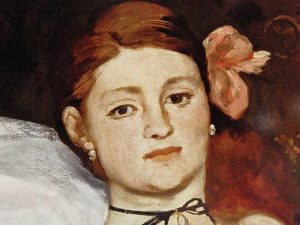
Paris Red is from the perspective of Victorine, a seventeen year old girl who sees the world through a very analytical lens. She is very bold but is very thoughtful about her actions and intentions, which is shown throughout the book as she interacts with other characters, especially when it comes to Manet and Nise. Both are people whom she has a profound connection t, and whose lives change greatly because of her decisions.
Victorine’s decisions end up sending her life into a new direction, and though at times it may seem that Manet is only giving her certain options, she has the ability to influence the situation through her actions. For example, when Manet is talking to the man at Flicoteaux’s, she puts her hand on his leg in order to draw the attention back to herself. She attempts to do so in a way that the man and Nise do not witness. She understands early on that she wants Manet for herself and acts with intent even though she doesn’t really want to hurt Nise: “And I slip my hand over his leg. A secret touch that I tell myself Nise will not see, nor the man who is standing there, talking and talking… And I tell myself she should not care, because even if he had taken the chair beside her, she would not have dared to pivot her arm and touch him” (Gibbon 53-54). This action is a defining moment because it is one of the actions that leads to the divide between Nise and Victorine.
That being said, the actions of other characters are important, too. For example, Manet makes very specific choices that influence Victorine’s decisions, but he does seem to leave room for her to decide for herself. For example, he offers her a job as his model but does not make it so she has to make that decision; he reminds her that she can keep working her current job if she chooses to do so. Perhaps there is an illusion of choice in that, but the fact that he leaves it up to her is important. He seems to find value in her opinion, especially when it comes to art. He shows her many different examples of both his art and that of other artists, and she tells him what she truly thinks. He recognizes how she sees the world and how special that is, and he loves her for that.
Towards the end of the story, Manet tells her to “Make people please you… Make them work for it” (Gibbons 276). Both of them do that throughout the story, and to follow up that statement with the reveal of the painting feels profound. The way the story ends makes it feel like this is just the beginning. There is so much more left for their story, but so much has changed them up until this point. They have changed each other.
Paris Red
Mar 16th, 2023 by rhperry0033
Concealed within Maureen Gibbon’s novel Paris Red is a story about womanhood and innocence. It explores the concepts of power and sex through the intellectual lens of a young girl navigating through her youth and coming to terms with what it means to be a woman.
It begins with the premise of Victorine and her friend Denise as they live and work together in Paris. That is, until one day they come across a man that we soon learn to be the renounced and famous painter, Edouard Manet. Although at first, the readers know little about this man other than what both Victorine and Denise know of him– he is a mysterious and overtly seductive man whom shows great interest in the both of them for his own artistic and sexual pleasure. However, Victorine begins to pursue him outside of the three’s relationship and ultimately abandons her friend to follow Manet down a path consisting of a relationship dependent on sex and art. This hunger that Victorine feels can only be quenched by Manet as she leaves behind her old life to follow him into his own.
She becomes his muse, and in doing so is able to alter the way he commits himself to his art. Yet she is self-aware enough about their situation to understand the power dynamic between the two of them, and fundamentally refuses to be perceived as someone being taken advantage of. She refuses to be perceived as his object, although whether or not this is actually the case is ultimately left for the reader to decide. She is very young, as depicted in the narrator’s voice, which oftentimes feels naive and childish. This can be effectively showcased in the way that Gibbon chooses to write– her words are often conveyed in a broken-up and fractured way. This is seen in the way that the shorter chapters end, with typically lyrical phrases.
“Then It come with its threadlike feet and delicate wings. It drinks our sweat and tears, and once again we believe things are possible.”
Paris Red
Mar 16th, 2023 by mmwilliams5180
Paris Red by Maureen Gibbon gives an unconventional coming of age story. In most coming-of-age movies or books we meet the character as usually a naive young boy or girl that goes through some kind of struggle that makes them grow and makes us as readers consider our own evolutions. Paris Red does not do this. Our main character, Victorine is only seventeen but seems to know so much about the world’s harshness and its beauty. She knows hard work , heartache, and the body of a man. She even says herself that when she was a child she would ignore older people’s warnings about life so that she would be able to experience it fully ,the way she wanted to. Victorine thinks that because she is seventeen and experienced, she knows the world. She mentions this very often, usually saying phrases like “I am seventeen and neither my mother’s rule nor my father’s love could change me. I do not care what anyone else thinks except for Nise.” Saying this makes it seem like she is trying to convince herself that she knows what she is doing or what situation she is getting into, the clearest example of this is when she first kisses Manet she says “ I am seventeen and that moment I understand that when a man is hungry like that, what he really needs is to have something taken from him.” Victorine is already a very developed young lady and does not actually do much growing without the story. We see her learn about art and how she eventually became an artist herself, but for her character development there is little to mention.
We obviously see that there is a huge age gap and power struggle between Manet and Victorine, that Victorine is both consciously and unconsciously aware of. Within the story,an idea is brought up about the issue of who actually pays in the end? Since Manet takes care of Victorine financially as well emotionally she is very dependent on him. An important quote to explain this is “It is not always so clear what someone wants, or what money can buy, or who exactly pays.” Victorine first notices that her relationship with Manet is more complicated than just being lovers, when Manet leaves her for the first time. She has little money left from the last time she was paid, she thought about how her rent was already paid but he is the one who pays it, she also finally notices that she has lost her best friend in order to gain him. This relationship is basically textbook grooming but because of the time it is set in it is seen as acceptable.
Based on my own research I find it odd that Gibbon made the character seventeen when Victorine was eighteen when she met Manet. There was also no evidence to show that her and Manet’s relationship was even sexual even though the whole story is based on their sexual experiences with each other. In fact their sexual relations take up most the story to the point where it feels that there is no plot and this simply a story about a young woman’s rise into fame by using her sex.
Victorine and Griet- Foils
Mar 16th, 2023 by rjbillings
Victorine and Griet are two narrators from the books Paris Red and Girl With the Pearl Earring. In a fascinating sense, Griet and Victorine have become a foil in the sense that they are observant, unreliable narrators and artists at heart.
Griet begins her story by explaining every molecule in her life. From the color wheel that is the vegetables for the stew to the sheets that have even the slightest bit of dirt. She has created this fully developed setting of this story which immediately immerses us into her life. On page four, she starts off her imagery strongly by stating, “The woman’s face was like an oval serving plate, flashing at times, dull at others.” In creating this simile, the readers have an immediate idea of who this woman she described is, finicky, haughty, and pretty. Victorine has a similar gift with identifying the different hues and how the sun brings color to everything in her bedroom. One example of her use of imagery is on page 14, where she states, “In the early morning light, things still have not regained their color: not the box of candles, not the dark maroon paint someone used on one wall, not the dirty white of the other walls, not my blue dress or Nise’s brown one– not even my green boots.” At this moment, the readers are transported into her realm and see the not-yet colors of the wee morning.
An important thing that most first-person narrators have are their unreliability. In Griet’s introduction with her soon-to-be boss, she proves that she is unreliable when Vinnier asks, “And do you spend much time setting out the vegetables before you make the soup?” to which Griet immediately responds, “‘Oh no, sir’ I replied, confused. I did not want him to think I was idle.” Yet her sister gives away that Griet is lying by staring Griet down until she admits to us that she lied. Victorine is just as unreliable as Griet, perhaps more. When Victorine first speaks about Denise, she says on page 16 that she is like a sister to her. Yet on page 32, when she is feeding Manet cherries she explains, “And if we had gone on sitting there much longer I would have kissed him. I would have kissed him and would have not cared if Nise was beside us or not.” except we know that is not true because soon she feels a wave of guilt rush over her and looks back at her “sister.”
To compare Griet and Victorine would not be much of a stretch, as they are quite similar to each other. They have similar poor backgrounds, and their artistic descriptions of color are similar. Even in these first few pages of their books, they seem to already have an artist hidden in them.
Paris Red: A Collection of Parallels and Differences
Mar 16th, 2023 by khkyzer
Paris Red is a collection of moments in the setting of a story. We are shown these intimate moments alongside short conversations that seem to have no significance. These small conversations keep you wanting more and more from the relationship, but it never comes. There is no happy ending for the love between two people who could not work logically. Griet did not get a happy ending. Louise did not get a happy ending. It is a harsh reality shown through the process of artwork. How art can be so intimate. How you can be intimate with another person, and you can also never live your life with them. How you can become so intimate with a person and still be behind an emotional or physical wall.
I think a notable part about this story is seeing how this is both similar and different to Girl with a Pearl Earring. First we look at the difference in how each character carries themselves. Louise has, sort of, more fire under her, as it seems in the writing. Louise and Griet both have a certain curiosity towards people and things, but Louise does it for fun. Griet does it to understand. Louise creates her life for her, while Griet has her life paths chosen for her. Louise and Griet both sit for art. Louise and Griet both answered to a man. Money is an issue with both Louise and Griet. Desperation can be seen in both stories. Desperation for love, but also financial security. The complications with a story about both.
Yes, there is something to say about the time period. After reading both books, I believe that Griet and Louise would act in a similar way. Griet serves the “masters” that she has, but what if she didn’t have to? Louise still serves her “masters” as well, but because she needs the money, and it is a better option. I believe that if Griet had the option to make art like Louise does, she would. Time makes a serious difference in the ways that people act. If the times were switched, what would be different? Would Louise be subservient like Griet? Would Griet act as Louise does? I think they would.
Paris Red
Mar 16th, 2023 by Eleanor Yeatts
What intrigues me most about this book is Louise’s relationship between her independence and her dependence. From the age of 15, she made it clear to her parents that she wanted to make her own decisions and learn things for herself. Which is further expressed by her declaration of learning later in the book where she states that she learns things by doing them, rather than taking advice from others. She leaves home at 17, with close to nothing, and begins to find herself at this age. Though she portraits herself as an independent woman, I don’t think she is independent at all. She shares a room with Nise. They share a bed, a job, a life, a man. I think she grows tired of it all when she decides to leave Nise for Eugene, acting as though she is a maverick of sort, though all she is really doing is acting impulsively. I think that is true to her character especially considering she is 17, and like most teenagers, she wants to find herself, and in ways she does. But she goes from home, to Nise, to Eugene, depending on all of them along the way. She craves their care and attention the way a child does from their parents, I think she sources those needs from others because of her refusal to accept it from her parents. I wish there was more detail about her relationship to her family so that I could try to further understand why she acts this way.
Paris Red
Mar 16th, 2023 by Emily DuBois
While reading Paris Red, I found myself waiting for something immense and groundbreaking to happen. It took several pages before I was able to formulate any definite judgment–affinity or distaste–for Victorine. Ultimately, I arrived at distaste with a smattering of respect. Her independence and analytical skills are admirable, but her overconfidence borders on arrogance. From the beginning, readers can tell that Victorine is intelligent and perceptive. This is shown in her analysis of people, her attention to detail, and her deductive skills. However, she strives ahead of others in order to get what she wants, and while it is clear that she does consider others (namely Nise), her actions–lying about where she’s going and making selfish remarks while in the company of both Manet and Nise–cannot be considered kind by any stretch.
In the second half of the story, there was a passage that was fascinating in that it outlined exactly how Victorine of Paris Red and Griet of Girl with the Pearl Earring are both quietly similar and starkly different. Spanning pages 203-204:
“… that is what I always craved–experience. With the boy I stayed out with all night when I was fifteen, with the man I left home for, with the long-lashed soldier who held me on his thighs, who made my tongue sore. Because even as a girl I never believed older people when they said things to warn me. I wanted to be taken out of my level of experience. My depth. Sometimes things happened and they were shocking. Or painful. But that is how I became accustomed. And some things I never became accustomed to. That was the price I had to pay for experience.”
It was while reading this passage that I realized that Victorine and Griet are mirrors of each other.
- Griet is level-headed and overly cautious, always thinking of her family and pondering the dangers that may come with the choices she makes. Towards the end, she takes on bold traits that even she doesn’t seem to realize are present and in the final chapter, she has comfortably settled into the role of butcher’s wife and mother.
- Victorine could not be more different; while just as intelligent, she is more impulsive and is estranged from her family to a degree. She does not appear to have readily telling changes to her character, though by the end, she is conscious of her financial ties and is even encouraged to pursue art professionally while the prospect of marriage is never mentioned once.
Griet and Victorine are two sides of one coin: security and freedom, tradition and unorthodoxy, spontaneity and premeditation.
Paris Red
Mar 16th, 2023 by ashantibrown
Paris Red by Maureen Gibbon was definitely not what I expected when I opened the book, especially when comparing it to Girl With A Pearl Earring. Readers are thrown into a world of art, mystery, and sex shown through the eyes of a 17 year old girl. There is little to be imagined. While reading this book I found myself having a reaction of annoyance for the main character through her thoughts and need for excessive validation. Making a competition with Denise where there did not need to be one, who was chosen to be kissed first and whom Manet would pick to sleep with. Overall I found myself disgusted and blaming Manet for praying on the two young girls. I was reminded of the feeling of being 17 once and thinking I knew everything when really I knew nothing about the dangers the world possessed.
I found myself focusing more on the relationship between the two more than the art that was being created unlike Girl With A Pearl Earring. There was more of an emphasis on these parts than anything else which led me to wonder why. The pleasure of thinking about something that you know to be forbidden, the want and need to be touched. All things so different from art but an experience that many people do have all the same.
Below are the questions you posed. I look forward to reading your blog posts and discussing these questions in class.
Paris Red
1. Do you think that sex was needed to move the story forward? Was sex a necessity and what did it accomplish?
2. Is this story more about the exploitation of a young woman or her empowerment?
3. How does Victorine achieve significant character growth?
4. The novel frames Victorine and Manet’s relationship in a positive light, though she is 17 and he is 30. How can modern standards be reconciled with this?
5. How would you describe the relationship between Denise, Manet, and the narrator?
6. The novel prompts the reader to consider a woman’s relationship to her work in a time period in which it is not proper for a woman of Louise’s stature to be without a job that suits her social status, especially because she is not occupied with children or familial obligations.
7. This novel can prompt the discussion of what exactly a muse is, and if the artist-muse relationship is more of a partnership or a one-sided parasitism.
8. Why are Louise’s carefully planned actions so important throughout the novel? The author makes sure that they stand out, and that the reader knows.
9. Does Victorine maintain control of her narrative or does Manet ultimately control her? Or is it she who controls him? There is obviously a power imbalance, but who is being taken advantage of?
10. What role did money play in the novel? How did that influence what the characters did?
11. How is Victorine a sympathetic character versus unsympathetic?
12. At what point should a person’s desires be placed above the feelings of their loved ones?
13. What are your opinions on Manet throughout this book?
14. How does Louise push the boundaries of her time period and encourages readers, especially women, to question boundaries that they are or could be pushing?
15. How does the time period impact the choices made?
16. Why does the story end seemingly open-ended?
17. Manet becomes himself because of Victorine, but who does she become? Is she still the girl in the painting?
18. How does the following statement by Victorine help frame her character throughout the novel? How does it work in tandem with her development (if any)?: “There is the body he sees and what I am. I know they are two different things. I understand that.”
19. What purpose do the short sections serve in this story? Do they reveal something about character, her naïveté and youth? Is there a deeper meaning to the lyrical endings and repetition to words like “want” and “need” and “hunger”?
Paris Red and Girl With a Pearl Earring
1. In both novels, the main character, a woman, created their own art eventually. What do you think was the difference in motivation behind each of the characters creating their art?
2. What do the characters of Griet and Victorine show about coming of age in their times?
3. In what ways are Victorine and Griet similar? Different? What are some noticeable reactions to scenes within Paris Red where Victorine may echo Griet?
4. How can Victorine’s goals/motivations be compared to Griet’s?
5. How was the descriptions in settings different and similar in Paris Red and Girl With a Pearl Earring? Was there more imagery in one than the other? Did you feel they were more similar or more different?
6. Both Girl With a Pearl Earring and Paris Red raise questions about the dynamic between young women and older men. It makes me, and likely other readers, question what it is about this time period that leads women to need to feel wanted by such men.
7. In what ways are Griet and Victorine similar? How would they have acted in each other’s place? How are they different?
8. How is the perspective of an artist shown by Louise in Paris Red in comparison to Griet in Girl With A Pearl Earring?
9. By the end of the novel, do both protagonists remain true to themselves or do they lose themselves to this artistic world that feels almost out of their league?
10. Why do you think the narrators in Paris Red and Girl With a Pearl Earring both only refer to the man in their lives as “he” and never by their name?
Coming of Age in Paris Red
Mar 14th, 2023 by Kate Dearie
The central theme of this story, or at the very least its prominent content, is sexual desire. It’s intertwined into every word in every section on every page. Sex, desire, and the discovering of new experiences. We follow the tale of this young girl, only seventeen, named Louise (or Victorine as she calls herself) as she comes into her own as a young woman learning about herself and the world. A sub-genre I’d categorize this story under is “coming of age,” even though it seems to be a bit more provocative than that. In fact, there is so much sex or sexual intimacies mentioned, it can almost distract from the concept of a “coming of age” story. However, there is still a young girl who is leaning about herself and her autonomy and the importance of different types of relationships.
Though I had to ask myself, why is there so many references to sex in this novel? As I read further, unsure of who the artist in this story was entirely supposed to be (as both the lead man, Edouard and our protagonist Victorine were both artists of some sort), it became increasingly clear halfway through. Edouard is Edouard Manet, the famous painter, and Victorine is Victorine Meurent, his model for his famous work Olympia. The painting features a nude, young redhead with her hair pulled back as she lays on a divan- a maid of color at her feet. What I loved about this story, despite its consistent sexual content, is how well it mirrors the original piece of art. A young, naked woman with red hair lays across a divan. This image is brought up again and again in Paris Red as we see Victorine not only model for Edouard on a divan, but sleep with him on one as well. The story’s tone and lyrical prose is derived from the artwork itself, letting the reader know exactly the type of painting we’re referencing without even having seen it before.
Week 9 – Paris Red: Victorine’s Character
Mar 14th, 2023 by Grace Quintilian
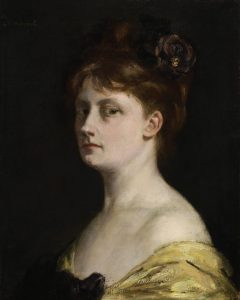 Maureen Gibbon’s Paris Red is a story about a young, poor girl who becomes involved with the much older, well-off painter Edouard Manet. At first, he courts both the narrator, Louise, and her best friend Denise simultaneously, taking pleasure in the idea of having them both, but this (predictably) fails, leading to a falling out between Louise and Denise. Throughout the three-way relationship, Louise is always the one to take the initiative with Manet, even to the point of excluding Denise, and this is what leads to the inevitable downfall of the threesome and the formation of Louise and Manet’s more exclusive pairing.
Maureen Gibbon’s Paris Red is a story about a young, poor girl who becomes involved with the much older, well-off painter Edouard Manet. At first, he courts both the narrator, Louise, and her best friend Denise simultaneously, taking pleasure in the idea of having them both, but this (predictably) fails, leading to a falling out between Louise and Denise. Throughout the three-way relationship, Louise is always the one to take the initiative with Manet, even to the point of excluding Denise, and this is what leads to the inevitable downfall of the threesome and the formation of Louise and Manet’s more exclusive pairing.
From the beginning of the story it is clear that Louise, or Victorine, as she calls herself, is a hedonistic and self-interested character. She knows her desires and does not hesitate to pursue them, regardless of the consequences to those around her or even to herself. She has a keen understanding of the relationship dynamics between herself, Nise, and Manet, and chooses to behave in ways that she knows will be hurtful to Nise simply because she wants to, and because getting what she wants is more important to her. She seems to be aware, in theory, of the financial irresponsibility of leaving her stable (if stagnant) job to become a model de profession, entirely financially dependent on her new, much older boyfriend, but she does it anyway. She values potential reward over any amount of risk, and never thinks about the long-term. All of this is attributed to her age, which is repeatedly emphasized: seventeen. She is a teenager, and underage by today’s standards (while Manet is, notably, thirty years old). She is not an emotionally mature person, and her every action reflects this.
Victorine is very consistently characterized in the way I have described, but I could also be more generous in my framing of her personality. She could be considered ambitious, self-aware, and free-spirited. She is certainly socially cognizant, making highly accurate assessments of Nise’s and Manet’s mental states and motivations, as well as her own (which, to me, makes her actions all the more frustrating — that she knows why she does what she does as well as the effect that it will have and still chooses to do it is less forgivable than stupidity). She is also, again, seventeen years old, and her actions can only be judged as those of a seventeen year old. Presumably, some of the more admirable sides of her personal qualities will shine through with age — however, the novel ends as soon as she begins to move in that direction.
The end of the novel is a beginning more than anything. Victorine has initiated a reconciliation with Nise, has begun to explore her new profession by posing for someone other than Manet, and has come to a realization about her own love of art and color — something Manet expresses a desire to nurture. Through her relationship with him, doors have been opened, and by the end of the novel, when she sees the finished product of Olympia, she seems to be on her way to becoming self-realized — an optimistic and satisfactory conclusion.
Week 8 – Autumn at the Automat
Mar 2nd, 2023 by Grace Quintilian
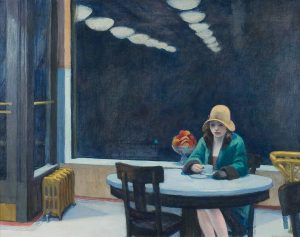 The short story “Autumn at the Automat” by Lawrence Block follows an older woman as she eats her dinner at an automat. On its surface the story seems boring, but there are layers to her experience that keep the reader interested, and all the while it is clear that she is building to something. The first thing that she thinks of in the story is money — how to ration her nickels throughout the year — and this is a theme that will come back up continuously until its relevance is finally revealed to the reader near the end. It is made clear to the reader, in a subtle and well-integrated way, that this character was once well off but is now suffering from financial difficulties since the death of Alfred, likely her husband. She talks about her clothes, which are good but worn, and her apartment which is much the same, and Alfred, who she imagines speaking to her, but who is long gone.
The short story “Autumn at the Automat” by Lawrence Block follows an older woman as she eats her dinner at an automat. On its surface the story seems boring, but there are layers to her experience that keep the reader interested, and all the while it is clear that she is building to something. The first thing that she thinks of in the story is money — how to ration her nickels throughout the year — and this is a theme that will come back up continuously until its relevance is finally revealed to the reader near the end. It is made clear to the reader, in a subtle and well-integrated way, that this character was once well off but is now suffering from financial difficulties since the death of Alfred, likely her husband. She talks about her clothes, which are good but worn, and her apartment which is much the same, and Alfred, who she imagines speaking to her, but who is long gone.
Throughout the story, the main character spends much of her time focusing on apparently tedious things, contemplating nickels and dessert and the woman putting too much sugar in her coffee, and is repeatedly called out by her imaginary version of Alfred for “stalling.” What is she stalling? Near the end, the reader learns that she has been planning a scam against the restaurant in order to make money. This revelation makes everything that led up to it make sense — her focus on money, her “conversation” with Alfred, her focus on the other patrons of the automat. When she returns to her apartment, successful, she speaks to Alfred again. He is the one who taught her to scam in this way, and now, without him, she is learning to do it on her own.
The “conversations” that this character has with her husband in her head reveal as much about her character than they do about his. Through them, we gain a tangible sense of her loneliness. We can sense the strong presence that he had in her life; she makes many references to his having taught her things about life. He taught her to prefer strong coffee, and he taught her how to watch a person through her periphery without really looking at them — a strange skill. It is obvious simply by the fact that these imaginary conversations exist, and that they are so frequent, that Alfred’s absence weighs on her every day. Despite the tension building up to the scam and the anxiousness of wondering what is going to happen, the overwhelming feeling of this story is loneliness.
“Autumn at The Automat”
Mar 2nd, 2023 by Cynthia
“Autumn at The Automat”, by Lawrence Block, took me as a reader on a bit of a ride before settling on its final theme. This is not to say that the author struggled to find one – the author, instead, took the reader on a journey and essentially made us work for the story. They did this by slowly giving the reader information to questions we get at the beginning of the story – why was this woman at the Automat? Who is Alfred? Once we learn that this is the woman’s late husband, it makes the reader question what he taught her? Why does she watch people – is it just her own amusement? But then why was she taught to watch from the corner of her eye?
It’s not until the very end of the story that it’s revealed to the readers that the woman was planning to weasel her way into some money by allowing herself to be accused of stealing silverware from the Automat. When it’s revealed that she brought her own and did not, in fact, steal, she was paid off to prevent her from going to her nephew lawyer (which did not exist). What I really liked and appreciated is that we weren’t told of her motives until the very end, when she returns to her hotel room and pays off her rent. This is when we as the reader learn that our narrator has done this several times in the past, all to different automats, and plans to do it again.
The Woman In The Window
Mar 2nd, 2023 by Eleanor Yeatts
I’m intrigued by the complexity of each character and the man and woman’s shared desire to kill. Both the woman and her lover (?) are trapped in relationships they don’t really want any part in, but they both desire something from the other, just not love. This story reminds me of stories written to teach people a lesson about sin. I think the woman could easily be written with a focus on greed and the man a focus of lust, both of which lead them to the desire to kill, but not to change. I’m interested in the fact that murder seems to be the only solution on their radar, that they would rather live miserably, but be wanted, than try to change and do something that makes them happy, or at the very least less unhappy than their current situations. Additionally, I wonder about the man’s wife. Surely if the woman takes up this much of his time, the wife must know and I wonder if she fantasizes about killing him. Further, this desire to kill seems to me to be a reflection of how they feel about themselves, evident in the text when the woman speaks about wanting to die or wanting to kill herself, and yet, still she waits nude for the man in the chair, doing nothing but hiding shears and wishing he was different, that she was different, that things were different. I wonder what she would do if she did try to change her situation, or if she’s even capable. Her mind, in many ways, is catered for him and I expect it would take a very long time to escape that kind of mindset. I feel sorry for her.
“Autumn at The Automat”
Mar 2nd, 2023 by ashantibrown
“Autumn at The Automat” by Lawrence Block reminds me of the calm before the storm. There is a sense of serenity and calmness while reading the piece even though it is about a woman’s devious ways of getting money. Block draws the reader in with descriptions of what is surrounding the character and what is going on around her. The reader is able to tell that there is intention behind this other than just contributing to the story. Block’s use of characters are also very interesting. In the story Alfred has died, but he still is an integral part of the story. He speaks internally and is shown through flashbacks that the main character has, which I thought was beautiful and showed true artistry on Blocks part. Something that I noticed as well was the lack of mentioning the time period of when the story takes place. There is an importance for that, but with the details given we can assume that this takes place at a later time, when money held more value, which makes me think what the story was trying to get across. Does money hold more value or are we placing too much value on money and material things?
“Autumn At The Automat”
Mar 2nd, 2023 by Emma Alexander
Lawrence Block’s “Autumn At The Automat” introduced an interesting main character from an interesting perspective. The narrator is from an outside perspective, and pays very close attention to a woman sitting at a table drinking her coffee. Though the majority of the story is from the third person perspective, the beginning looks at things through a second person point of view, making it feel as if you are one of the other people at the Automat. This also shows the reader that much like the woman in the story, the narrator is incredibly observant.
The reader is immediately drawn to the main character because of the way she dresses and acts while observing other customers. She is very observant but makes sure that no one else can tell, and only makes herself known when she deems it to be the right time to do so. Though many of her decisions are dictated by a voice of someone she knew, guiding her through every step of a plan that the reader does not know till towards the end of the story. “She had to smile. If some corner of her own imagination was supplying Alfred’s dialogue, it was doing so with great skill” (Block 269). This voice not only helps her financially, but also provides her with someone to talk to at times, seeing as she lives alone and is doing her best to get by. Clearly this person had an impact on her life, and continues to have an impact even after he is gone. The reader is left with many questions at the end of the story, which include why exactly Alfred is gone. It does, however, suggest that the woman will continue to pretend to steal cutlery at other Automats in order to make money.
Autumn at the Automat
Mar 2nd, 2023 by rhperry0033
 Lawrence Block conveys a narrative using the properties of deception and trickery, and in turn, uses this to conceive a story that leaves the reader in the dark up to the very end. The motives of our main character, who remains unnamed, are concealed from the reader until she acts on them. It is through the perceptions of the characters around our protagonist that we learn what her plan was. As the events unfold, we gradually come to an understanding of her intentions, and the happenings that had occurred prior to the climax of the story begin to piece together. We are purposefully made unaware of what’s happening until it happens, although hints strategically placed throughout the story begin to surface as we are quickly made aware of the protagonist’s objective.
Lawrence Block conveys a narrative using the properties of deception and trickery, and in turn, uses this to conceive a story that leaves the reader in the dark up to the very end. The motives of our main character, who remains unnamed, are concealed from the reader until she acts on them. It is through the perceptions of the characters around our protagonist that we learn what her plan was. As the events unfold, we gradually come to an understanding of her intentions, and the happenings that had occurred prior to the climax of the story begin to piece together. We are purposefully made unaware of what’s happening until it happens, although hints strategically placed throughout the story begin to surface as we are quickly made aware of the protagonist’s objective.
“Upstairs in her room, she took the knife and fork and spoons and returned them to her dresser drawer. They were part of a set, all monogrammed with a capital J, but they had not been her mother’s.
Nor were they sterling.”
The protagonist often speaks within an internal dialogue that she shares with Alfred, a past relationship that seems to have been very important to her, and also seems to be someone who has not only taught this trade to her, but also still carries such a high level of significance even after no longer being present– the departure of this character from her life having severely impacted her. And though it is widely understood that Alfred has long since died, it’s never made specifically clear what has happened to Alfred. As with much of the story, we are left to make our own conclusions.
“Sometimes they came so swiftly, and with such unsparing candor, that she had to wonder at their source. Was she making them up? Or was he no less a presence in her life for having left it?
Perhaps he hovered just out of sight, a disembodied guardian angel. Watching over her, taking care of her.”
Alfred seems to be acting as a sort of conscious for our main character. His inner dialogue appears as a guide– steering her towards her ultimate goal and keeping her on task when her mind begins to wander elsewhere. The significance of this phantom-like character is so heavily woven into the actions and dispositions of our protagonist that we are left to theorize what has happened to them, and why.
to be acting as a sort of conscious for our main character. His inner dialogue appears as a guide– steering her towards her ultimate goal and keeping her on task when her mind begins to wander elsewhere. The significance of this phantom-like character is so heavily woven into the actions and dispositions of our protagonist that we are left to theorize what has happened to them, and why.
Ultimately, the main character succeeds with their swindling. And although a thief, we are made to sympathize with her. Her actions are deemed justified, as she attempts to make ends meet in a society that feels economically difficult to navigate through, even with the aid of an inner voice.
Ghost of Alfred
Mar 2nd, 2023 by mmwilliams5180
Lawrence Block’s “Autumn at the Automat” opens with a woman sitting in the cafeteria and observing people. From the beginning we know that this woman is not exactly alone. She is being haunted. This haunting isn’t from some ghoul or ghost but it is her memories. She hears Alfred talking to her and guiding her but she doesn’t seem to mind it. It is even said that she welcomes his ghost, this can be shown in the line “As she alternately hoped and feared, it didn’t all stop with the end of life. Suppose that fine mind, that keen intelligence, that wry humor, suppose it had survived on some plane of existence even when all the rest of him had gone into the ground.” During the story we see Alfred guiding her multiple times. We see that he taught her how to enjoy black coffee, look in the corner of her eyes, and basically how survive.
We don’t know too much about Alfred but we do know this: He was German, most likely older than the narrator, liked his coffee black but still liked sweets, and probably was a really good conman. While he is never physically in the story we know that he has had a huge impact on the narrator even in death.
The Woman in the Window
Feb 28th, 2023 by smcote
This short story by Joyce Carol Oates depicts the story of a woman living– unhappily– as the mistress of a married man. He supports her financially, to an extent. She still works at an office, as a secretary, and resents his half-support, the money given to her like an afterthought and the expensive shoes she hardly had occasion to wear. Opening, we are told she’s hidden something in the blue chair, but tries to assure herself she will not need it, giving a sense of suspense and mystery to the reader. Later it’s revealed to be sewing shears; what she calls “A weapon of revenge. Not a male weapon but a female weapon: sewing shears.”
This relationship is an example of the skewed power dynamics between man and woman. We see her waiting for him obediently, nude– not naked, as she explained– while he arrives late, clearly not having much respect for her, not seeing her as a priority. She recalls the men who have taken advantage of her before, Mr. Broderick, Mr. Castle, and her current boss, Mr. Tvek; however, he remained unnamed. Despite being the object of her frustrations and someone she deeply wants to punish, it’s almost as if she is protecting his identity. She wants to punish him, and take control somehow; but without her benefactor, she could not afford her apartment, not on a secretary’s salary.
As we change to the man’s perspective, we get an insight to his own inner grievances. He spends a while thinking about alcohol, how early in the day it’s appropriate to drink. He shows his true feelings for his mistress, calling her a “deceitful little bitch” for drinking alcohol– that he purchased and brought to her. He compares her and his wife, looking down at both, not realizing that he could be the problem that causes their insecurities and complaints. As it turns out, he daydreams of killing her as well. Unlike the woman though, he’s acted on violent thoughts before. With some ambiguity, he mentions a “tussle” with a French girl in wartime. Whether he killed her or simply harmed her is debatable.
The story ends with the man and woman about to meet one another, both ready to end this affair, out of the reader’s sight. A commentary on abusive dynamics in relationships, we can only speculate on how their last meeting plays out, and who survives.
The Woman In The Window
Feb 28th, 2023 by khkyzer
Joyce Carol Oates brings on a story about a man and a woman. The man, who has a wife, has a mistress who he financially and sexually supports. I think the biggest and most obvious theme in this story is the sheer male and female roles that are addressed within actions and emotions.
The man sheds light on the pure non-monogamous and power hungry nature that is stereotyped and often true with a lot of men. A man who has two women, yet dislikes both, yet still keeps both, yet still somewhat likes them a bit. It’s exhausting to read about and even more exhausting to experience. The woman then waits for the man. She has no purpose until the man puts purpose into her life. Her work and life are the background priorities, while the man is her main priority. The woman sits naked, sorry nude, everyday with high heels on, waiting for her man who is not even solely hers.
The most interesting part of this story is the theme of killing. Neither of them enjoy their situation, but both of them want to kill the person who is making their situation “miserable.” The wife is annoying, and the man is late. The woman goes through the explanations of how she could cover herself in the case that she did actually kill him. Making sure she had an alibi for using the sheers. The man acting purely out of anger, strangling the woman, to show his final blow of power.
The examples of power imbalance are absolutely riddled throughout this story. These gender roles are eloquently stated throughout the story to show how twisted living like this really is. How detrimental it is to stay in your box like the woman stays in her apartment, that she can’t even afford with the secretary’s salary.
The Woman in the Window
Feb 27th, 2023 by Kate Dearie
Something that Joyce Carol Oates does so incredibly well is differentiate between the text centering the man versus the woman. It’s quite clear who is speaking or thinking in each section based on the elegance of the prose or the structure of the sentences. Something else that Oates is able to do well is not only help us readers differentiate between the speakers, but see the differences and similarities between men and women. What’s the difference between a man and a woman who both long to kill? Their reason for wanting to kill. The woman speaks repeatedly of not wanting to kill but feeling like she wants to to stop the man, to harm him for harming her in the best way she knows how. To express all the rage and emotion she’s been holding back. The man, however, is also unsure if he wants to kill her or not, but decides he will only if she “acts out.”
A perfect parallel I loved about how these two points of view coincided was their means of murder. The woman planned to use her sewing shears and stab them into his throat. The man planned on strangling her. The metaphor is explained beautifully by this quote: “In the throat, the male is as vulnerable as the female” (191). Words, in this story, are each of the characters’ downfall. Neither wants to hear the other speak unless it’s something pleasant (or from the man, preferably no talking at all). Alluding to the throat as a vulnerability represents so much more than just the possible location of premeditated murder.
“What a man wants, she thinks, is a woman whom other men want but the woman must not seem to seek out this attention or even be aware of it” (201). This story does such an amazing job of getting into the heads of men and women in their rawest and purest forms, when it deals with sex, and explaining the other away. It does well to convey to the reader how men and women both view the act of sex and how each other should be before, during, and afterwards. There is so much to unpack in this story, but these are just some of the things that really jumped out at me.
The Music Room- How to Get Money During the Great Depression
Feb 23rd, 2023 by rjbillings
During a time when money was scarce, there was often chaos that complemented this scarcity. In The Music Room by Stephen King, the readers are taken on a journey through time to the Great Depression, where we meet a couple trying to make a living during these trying times. However, rather than going about making money by working tax-paying jobs, the readers are introduced to a couple who find money by kidnapping people and slowly draining their bank accounts. Once their bank account is completely drained, they starve their victims to death. However, during this story, the couple is met with a conflict; the victim will not die and the wife is starting to grow weary of the screaming. The husband and wife argue about whether they are murderers or not and at some point, the readers also contemplate whether or not they’re murderers and whether they are doing these things for fun or to stay afloat. The woman in the couple seems to have guilt or sympathy towards the victim, but is it truly sympathy? On page 123 we find that the more the victims struggle, the more excited the woman is about their money; In the book, King writes, “She looked at him in that same steady way, hands clasped. “And yet?” “Part of you enjoys it, I think. Not this part, but the actual moment when we take them, as a hunter takes an animal in the woods.” In a sense, she treats the money like a reward for her actions.
Week 7 – “The Preacher Collects”
Feb 23rd, 2023 by Grace Quintilian
 Gail Levin’s short story “The Preacher Collects” is told from the perspective of Arthayer R. Sandborn, a preacher who stole thousands of dollars worth of Edward Hopper’s early artwork from his childhood home and managed to not only sell it, but get it authenticated. While reading this story, I noticed two things. First, I noticed that while it was written in the first person, the events which unfolded were told in a very straightforward manner, with little involvement of the narrator’s reasoning, emotional state, or even his life outside of the crimes he committed. He felt shallow and one-dimensional, as if he were confessing to a series of events that he actually had no personal involvement in.
Gail Levin’s short story “The Preacher Collects” is told from the perspective of Arthayer R. Sandborn, a preacher who stole thousands of dollars worth of Edward Hopper’s early artwork from his childhood home and managed to not only sell it, but get it authenticated. While reading this story, I noticed two things. First, I noticed that while it was written in the first person, the events which unfolded were told in a very straightforward manner, with little involvement of the narrator’s reasoning, emotional state, or even his life outside of the crimes he committed. He felt shallow and one-dimensional, as if he were confessing to a series of events that he actually had no personal involvement in.
Next, I noticed that Gail Levin herself appears as a minor character in the story — she plays the role of a “too-curious” journalist who is undeniably wronged by her employer when he chooses to go along with Sandborn’s plan. These two things were connected in my mind when I learned that “The Preacher Collects” is based on a true story, which Levin herself played a part in. Levin paints a picture of Sandborn as a cold, emotionless liar and does little to develop his character, likely because she holds a personal grudge against him due to having lost her job at his hands. This presumption of his personality can be seen in lines like the following; “No one remembers Jo’s funeral. There wasn’t one. Who would have attended?” (162). This line is one of the few that displays any amount of internal reflection from Sandborn, and it portrays him as callous. After learning the backstory of this work, I lean towards the view that it is more an act of personal closure on something that the author had wanted to get off her chest, rather than an earnest piece of fiction writing.
The Music Room
Feb 23rd, 2023 by rhperry0033
 I believe that this story is a reflection of isolation and the sense of escapism, as also communicated through the painting itself. Knowing of the author’s background, the reader can already gauge where the progression of the story will ultimately lead. It is through both the author and artist’s portrayal of tone that the idea of a shared theme is evident in both works.
I believe that this story is a reflection of isolation and the sense of escapism, as also communicated through the painting itself. Knowing of the author’s background, the reader can already gauge where the progression of the story will ultimately lead. It is through both the author and artist’s portrayal of tone that the idea of a shared theme is evident in both works.
Their work together depicts a sense of loneliness from the real world, a detachment from society. The morals of the Enderby’s no longer align with the status quo, and each of their delusional state of mind feeds into one another. They justify each other’s actions and compel one another that what they’re doing is at the fault of society and not their own hands. This neglect of societal morals and the inflation of their own set of rules aid in the paradoxical idea that this isolation is the product of a greater issue.
Their acts are conducted as a way to make ends meet. It’s become their new ‘job.’ The current state of their time made carrying out a normal lifestyle and maintaining a comfortable income nearly impossible. That is a fundamentally inescapable product of the country’s ongoing expansion and growth. This self-inflicted seclusion is a byproduct of America’s continuous evolution. They’ve adapted to their circumstances in the most grotesque way. They’re living in their version of the American dream.
“When they were first married, there had actually been an Enderby Enterprises. The depression—what the Journal-American had taken to calling the Great Depression—had put an end to that two years ago. Now they had this new work.”
Even then, the justification for their actions is obscured by what we as readers know to be morally correct. The Enderbys’ narration cannot be relied on– they are unreliable narrators. What they deem to be just and true isn’t by any means, yet they speak and act a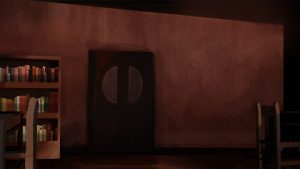 s though it is. Only through the perceptive and insightful observation of the reader do we know that this story belongs in the horror genre, even though from the point of view of the characters, it’s just another night doing their job.
s though it is. Only through the perceptive and insightful observation of the reader do we know that this story belongs in the horror genre, even though from the point of view of the characters, it’s just another night doing their job.
“But we are not murderers. Our guests simply lack sustenance, as do so many in these terrible times. We don’t kill them; they simply fade away.”
